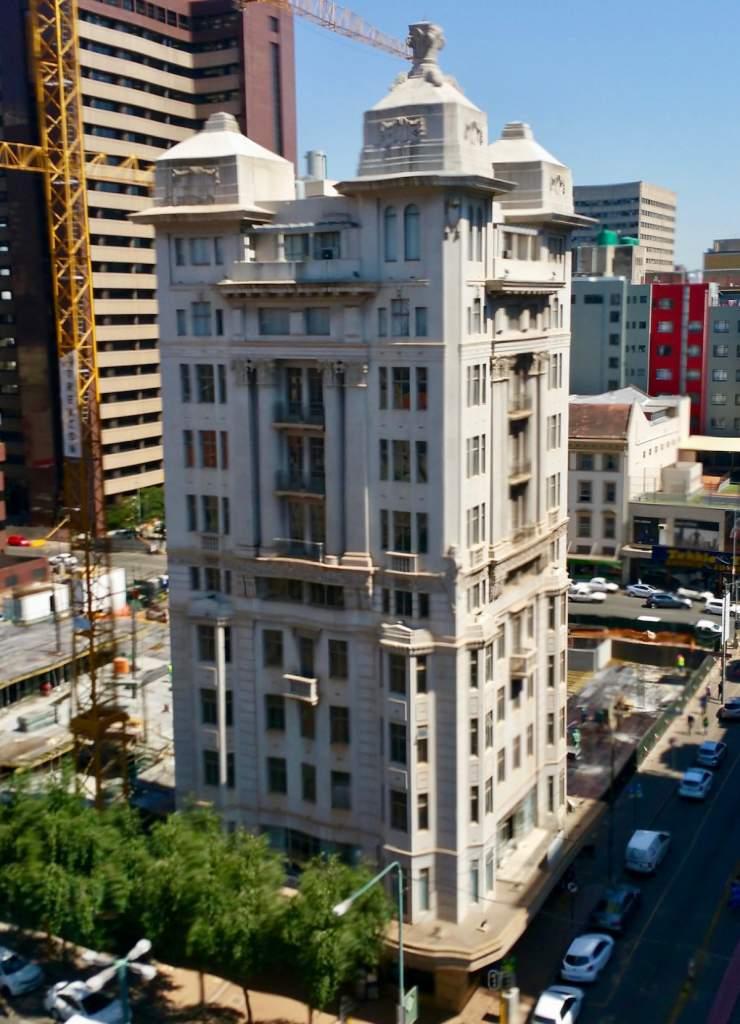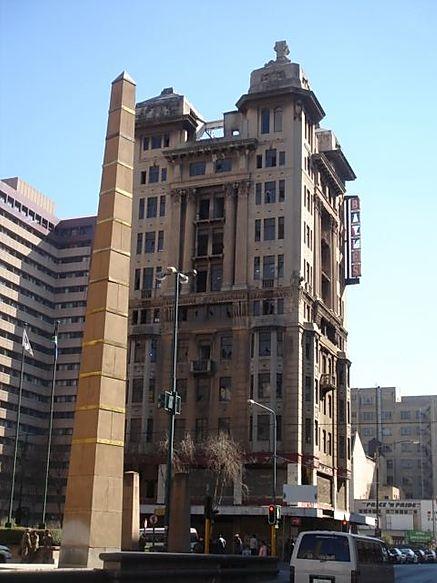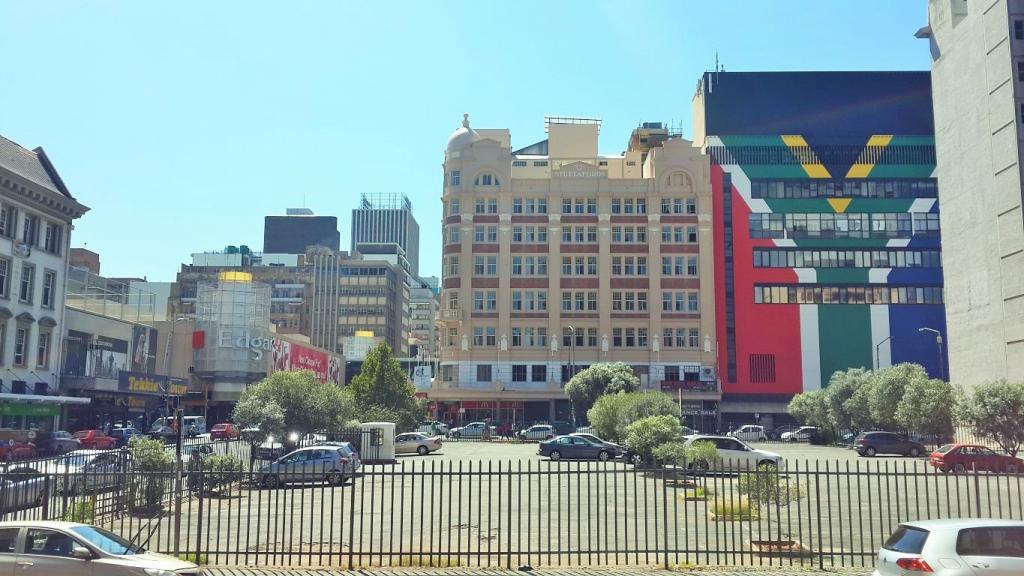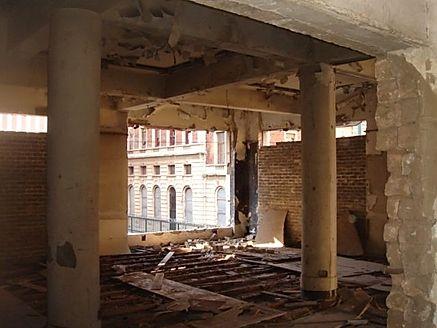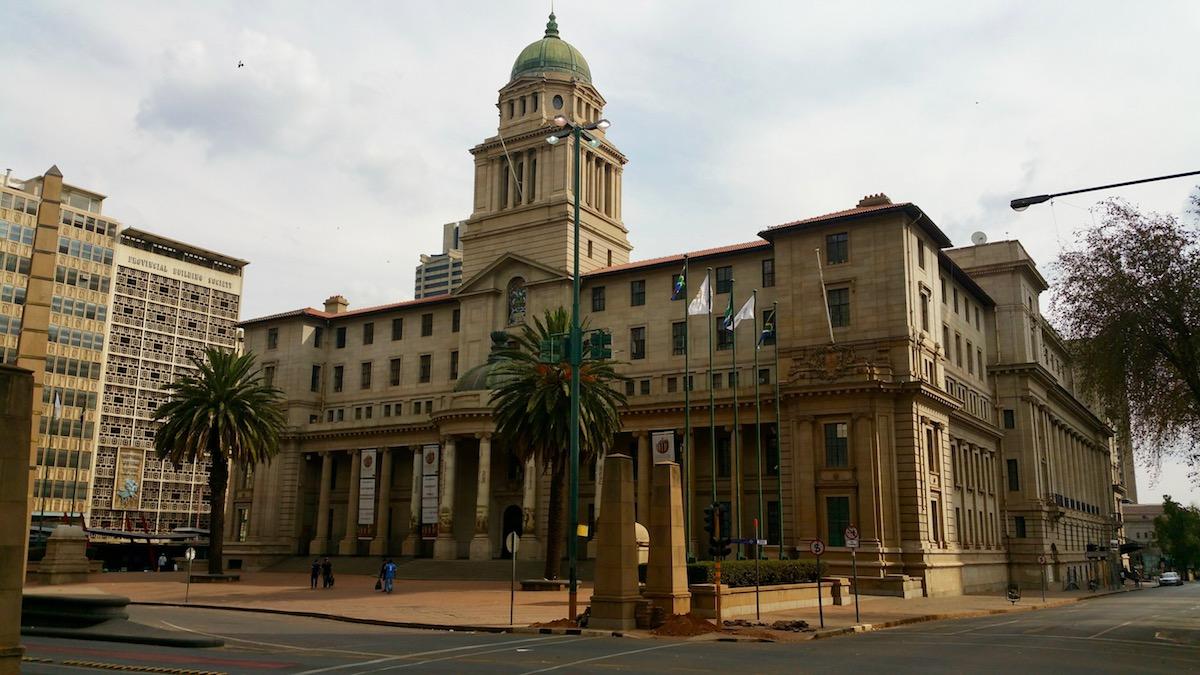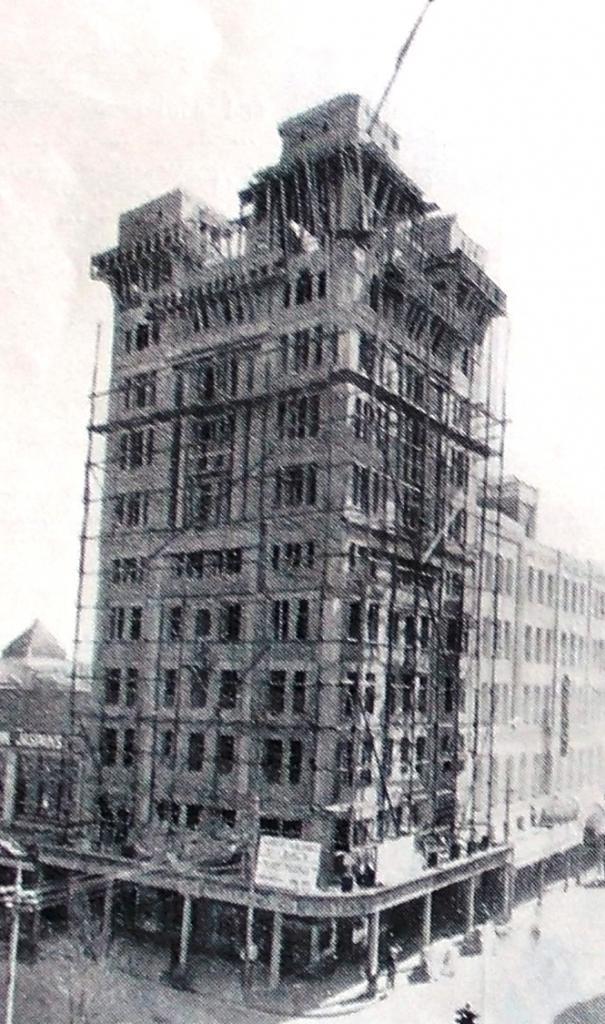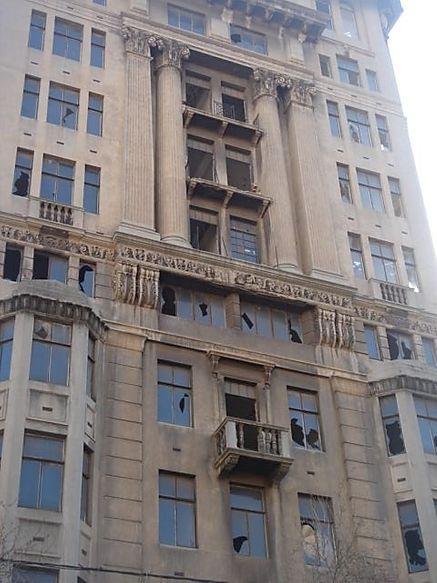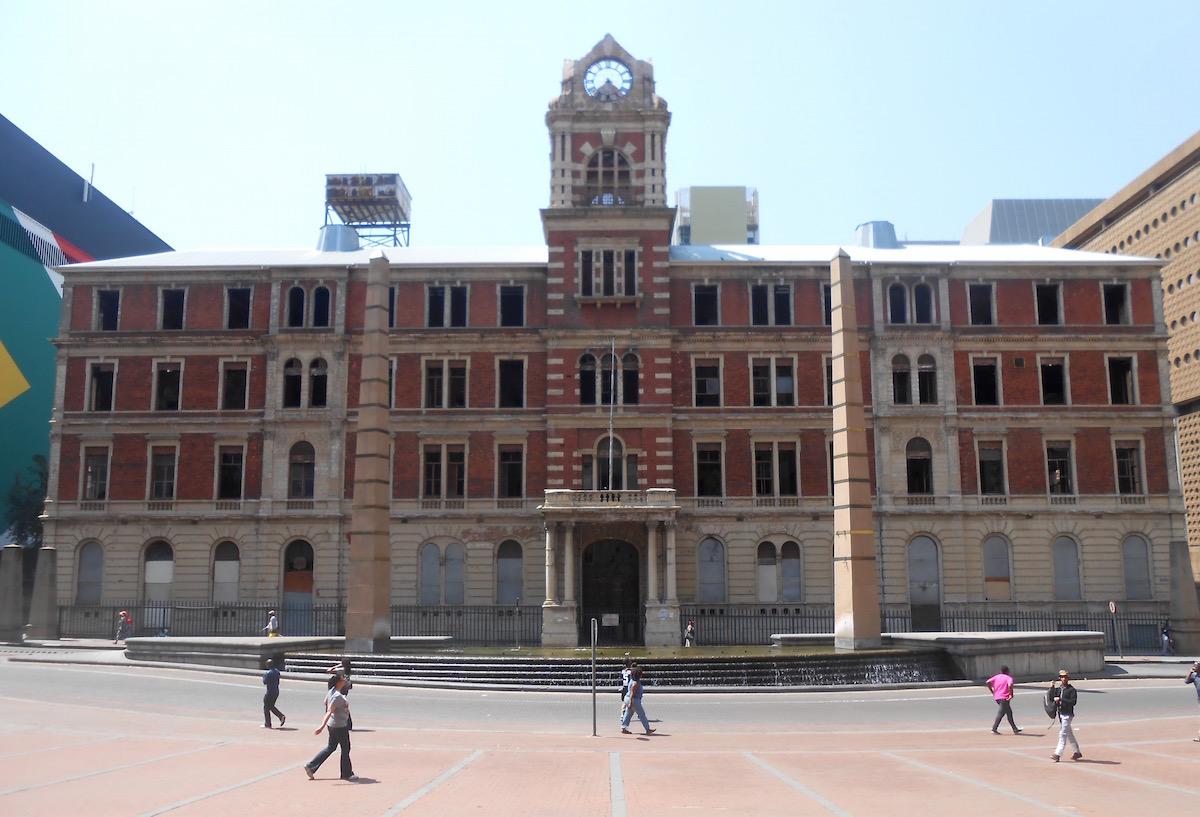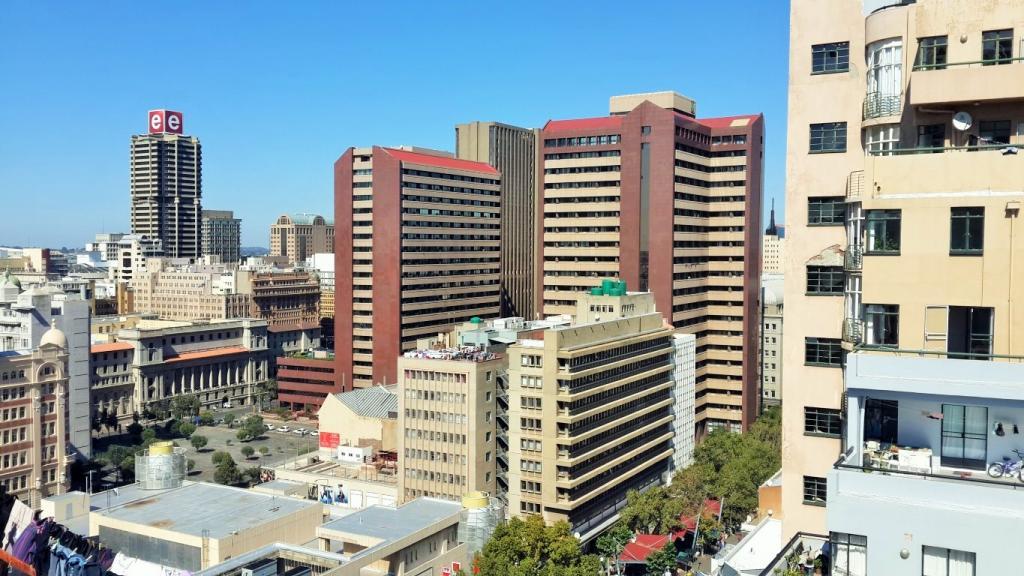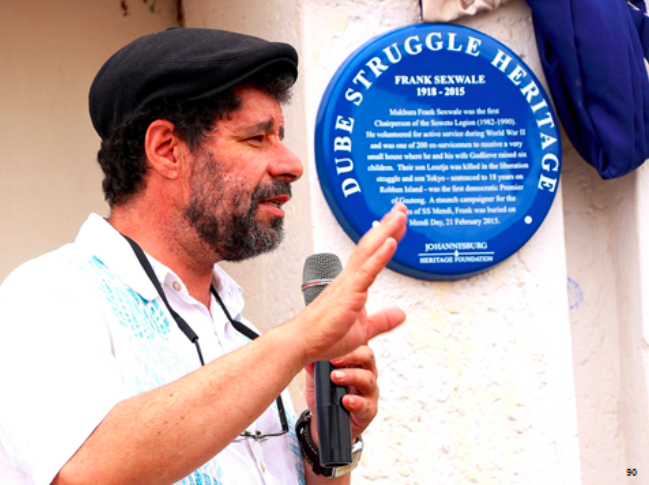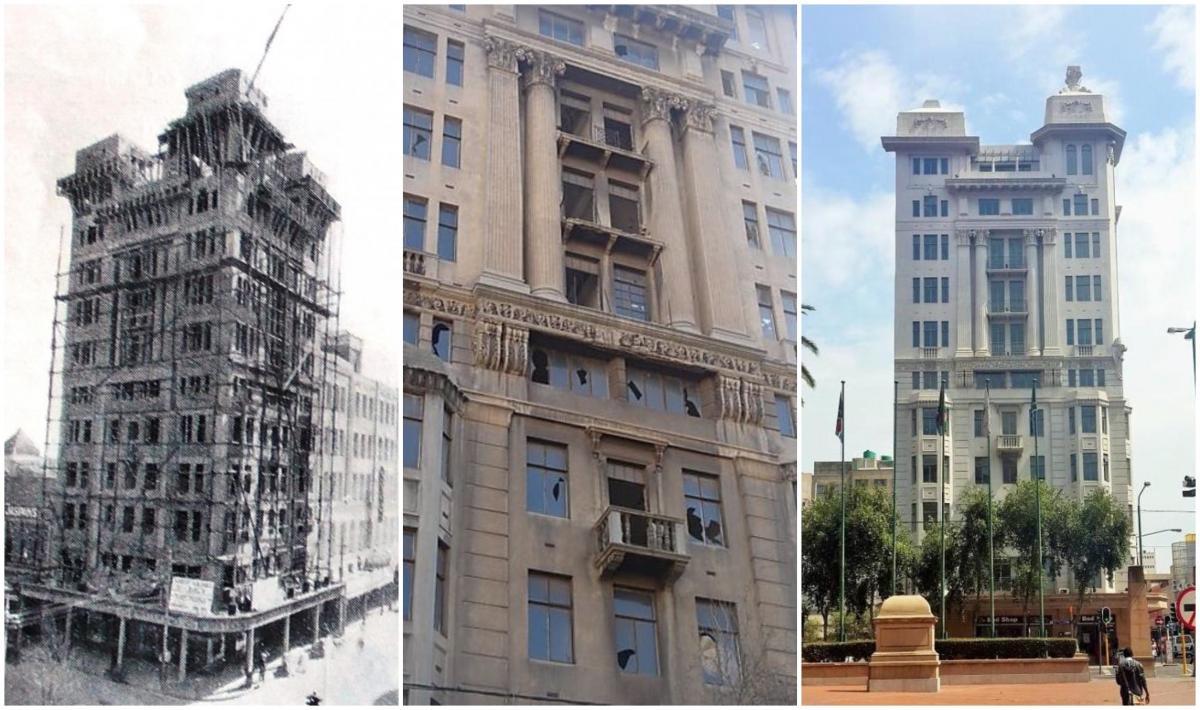
Disclaimer: Any views expressed by individuals and organisations are their own and do not in any way represent the views of The Heritage Portal. If you find any mistakes or historical inaccuracies, please contact the editor.
In the article below, journalist Lucille Davie unpacks the long journey towards the restoration of the iconic Barbican Building in the Johannesburg CBD. The piece first appeared on the City of Joburg's website on 8 April 2011. Click here to view more of Davie's work.
After 16 long years of neglect, Old Mutual can take a bow for restoring the dignity of the splendid Barbican, one of the city’s iconic buildings.
The 80-year-old, 10-storey building looks glorious, basking in the renewal of its freshly cleaned exterior, and floor after floor of new concrete screed floors, sparkling white walls, and restored balconies.
Barbican from above (The Heritage Portal)
“We see the Barbican refurbishment as the latest of the many strides over the last decade which have firmly turned the inner city away from decline,” said Ben Kodisang, managing director of Old Mutual Investment Group Property Investments (OMIGPI).
Old Mutual bought the building in 1995, and after clearing it of vagrants, bricked it up, leaving it to deteriorate. After years of pressure from the City and heritage bodies, restoration began in mid-2010, and the fruits of that work were revealed this week.
Neglected Barbican (Lucille Davie)
The building was completed in 1931 in a mix of eclectic classicism and art deco styles. Originally built with ground-floor shop space, a first-floor tearoom with a balcony with canvas awnings, and seven floors of offices, with a studio and servants’ quarters on the top floor, its Corinthian columns and ornamental cornices and railings make it one of the city’s most attractive buildings.
Old Mutual has plans to develop the neighbouring Palace site in the same block, but is reluctant to begin work until it has secured an anchor tenant. Some 2 360m² is available for rent.
Palace Site (The Heritage Portal)
The interior of the building had been stripped of anything valuable – metal heaters, wrought iron banisters, metal door and window frames, and wooden floors. This left gaping cavities in the facade of the building, with cracked and broken windows adding to its derelict look. Damage to the roof has meant that the top five floors had been extensively rain-damaged, and the entire roof had to be replaced.
Inside the neglected Barbican (Lucille Davie)
Old Mutual owns 28 buildings in the Johannesburg CBD, and pumped R20-million into the Barbican restoration.
“It stands out as a real marker,” says Eric Itzkin, deputy director of immovable heritage in the City’s directorate of arts, culture and heritage. “It was a beacon of progress and aspiration for the city, and it is again.”
Lindsay Butler, deal originator at OMIGPI, acknowledged at the unveiling on Thursday that the neglected building was a “very, very, very sad picture”, but said that the regeneration of the inner city was gaining further momentum.
Kodisang added: “This is a momentum builder, the inner city is ripe for further developments.”
He said the restoration would give impetus to the development of Old Mutual’s Palace site, which involves 25 000m² of office space, 15 000m² of retail space, and 900 parking bays. This would then incorporate three city blocks adjoining the Palace site, making it a retail and commercial precinct. It would include a pedestrianised Loveday Street, the FNB Bank City, and the provincial legislature.
The Provincial Legislature (The Heritage Portal)
Old Mutual has partnered with other property developers to convert some of it portfolio – Plaza Place, Persam Place and Royal St Mary’s - into residential units for entry-level tenants.
Old Mutual also owns property in Newtown, where it envisages a mixed-use development, with retail, office and hotel space of 23 000m².
Restoration
The restoration consisted of installing a new lift, repairing the historic concrete exterior moulding, pressure cleaning and removing the discolouration and pollution of the exterior plaster, and painting the interior.
A breathable cemetitious paint was applied to the facade, thereby allowing the building to release any trapped moisture, says architect Robin Fee of Fee & Challis Architecture, the firm that oversaw the restoration.
“The colour of the paint was selected to match the original colour of the building,” he adds.
Robin Fee (SAIA)
Missing steel external balcony balustrades were re-made, using old photographs, and installed on the 6th, 7th and 8th floors. The pergola on the south and east facades of the 10th floor has been re-instated.
The original wooden floors, which were largely destroyed by vandals and the weather, have been replaced with concrete screed floors.
The original bay windows on the first floor had been removed in the 1960s. These have been re-instated, together with a new steel canopy over the pavement.
All internal partition walls have been removed, creating open-plan offices. Two original offices have been left intact on the second floor, as a nod to the heritage of the building when first built.
Stairways have been given new life with new granite treads, with new timber hand rails and new terrazzo tiles.
Hi-tech solutions have been used in the replacement of the roof slab, with beams and slabs reinforced with carbon fibre strips which have been resin-bonded.
The cramped historic entrance has been opened up and a new reception area installed. The vaulted ceiling has been repaired and new lighting installed.
A new fire escape was installed, together with a new fire fighting system, in line with current building regulations.
“It’s been a wonderful experience,” says Fee.
Perhaps the restoration of the Barbican will hasten the restoration of the neighbouring 1897 Rissik Street Post Office, a process begun but making slow progress. The 1915 City Hall, opposite the Barbican, is to undergo restoration, starting this month.
* * *
This is an earlier story which gives more background.
Barbican to be restored, says Old Mutual - August 3, 2009
After years of broken promises, another act of vandalism has prompted Old Mutual, the owners of the beautiful but derelict Barbican in the CBD, to make yet another proposal regarding the future of the building.
“I have been mandated by Old Mutual Investment Group – Property Investments (OMIGPI) to lead an initiative for funding to repair, restore, and rehabilitate the Barbican Building,” says Lindsay Butler, deal originator at Old Mutual Investment Group Property Investments.
But this does not mean that the building will be available for occupation, adds Butler. His “comprehensive report motivating the funding” will be tabled at the OMIGPI Investment Committee’s next meeting on 11 August.
”I have applied for emergency funding, to repair and restore the Barbican. We will forget about the return on the investment.”
If approved, work will begin on site in November this year, says Butler. “It will not be brought back to occupation, that is a further cost exercise.” The repair and restoration will cost Old Mutual R19-million.
The 10-storey building, completed in 1931 in a mix of eclectic classicism and art deco styles, was originally built with ground-floor shop space, a first-floor tearoom with a balcony with canvas awnings, and seven floors of offices, with a studio and servants’ quarters on the top floor. Its Corinthian columns and ornamental cornices and railings give it an elegant, almost fairytale feel.
Barbican under construction (SA Builder Magazine)
Old Mutual bought the building 14 years ago, in 1995. At that time it was in serious need of repair, with squatters occupying the building. They were removed and the building was bricked up after plans to develop the Barbican and the vacant site alongside it were shelved.
The interior of the building has been stripped of anything valuable – metal heaters, wrought iron banisters, metal door and window frames, and wooden floors. Rubble and strips of wood lie everywhere, stairs are chipped and dangerous with missing banisters, and windows are gaping holes, open to the weather.
Neglected Barbican (Lucille Davie)
Workmen are on site rebuilding the walls on the ground and first floors, barring entry to the building.
The Barbican is significant architecturally, but also because it forms a triangle with some the city’s most important civic buildings - the 1897 Rissik Street Post Office, also in chronic need of restoration, and the 1915 City Hall.
Rissik Street Post Office (The Heritage Portal)
Roof and doors missing
The latest act of vandalism comes after architect Brian McKechnie noticed on 1 July that the glazed roof was missing, as well as one of the steel French doors to the 8th floor balcony.
”I assumed that the glazed roof and the French door had simply caved in, due to the years of complete neglect by Old Mutual, the owners of the building,” said McKechnie.
However, when McKechnie visited the city on Sunday, 26 July, he was in for another surprise. “I was absolutely shocked by what seems to be the systematic and deliberate gutting of the building. All the French doors and balcony railings have been stolen - apparently by vandals, leaving gaping holes in the façade of this once beautiful building.
”The Barbican has literally been doomed to demolition through the complete and indifferent neglect of Old Mutual. What is left of the building looks like a gutted shell, stripped out and awaiting the demolisher's hammer.”
He adds: ”Old Mutual is a company which apparently prides itself in commitment to the preservation of our environment and heritage. The reality seems to be rather different.”
2008 restoration plan
A restoration plan was to be implemented once heritage approval was obtained from the Provincial Heritage Resources Agency (Phra) in September last year. This permission was obtained, says architect Robin Fee of Fee & Challis Architecture, the firm commissioned to restore and renovate the Barbican.
”It is an iconic heritage building,” says Fee, “it is very lucky to have survived,” referring to the fact that squatters have lit fires on the wooden floors of the building.
The restoration was to see the complete rehabilitation of the exterior of the building, says Fee, plus the complete rehabilitation of the interior of the building in order to modernise the interior, to make it “attractive to upmarket tenants”.
Old Mutual was to spend in excess of R55-million on the restoration. The Barbican was to be restored together with the development of the whole site, called the Palace site, now vacant and used as a parking lot. This development was to cost R1,3-billion, and would take in the surrounding four city blocks that Old Mutual owns. These are the 1066 Building, the Mutual & Federal offices, and the York House block.
1066 Building and the Mutual & Federal offices (The Heritage Portal)
Old Mutual was expecting to sign up tenants for the site by early this year. Restoration and construction only begins once tenants have been signed, stresses Butler.
Not the Palace site
He has not applied for funding to build on the Palace site, although he admits that fully restoring the Barbican is dependent on the development of the adjoining Palace site. He says he is working on a scheme for the Palace site, so that its development can run parallel with the restoration of the Barbican.
The restoration of the Barbican last year was possible because a tenant had been found, confirms Butler. The Arena Group in London had shown an interest – they wanted to convert the building into a gentlemen’s club, with an element of residential space.
“They had zero financial sense,” says Butler, who was given the Barbican as part of his portfolio two months ago.
The scheme wouldn’t have worked, says Butler, because the potential tenant wanted extravagant fittings in the building. It was also felt that the UDZ concessions would help Old Mutual to renovate the building. “And the renovations were to be paid from membership fees,” says Butler, incredulously.
“We are seeking a very unique tenant – this is a crème de la crème building. But we have had interest shown by a national government department,” he says.
A tenant had also been found for the Palace site last year, but when it was at the approval stage, the tenant did an about-turn.
The development of the Palace site is complex, says Butler. Unlike other conversions in the inner city, where existing office buildings are transformed into residential units, a green fields site where construction starts from scratch, always costs more. And, by the time the building is ready for rental, those rentals would be sky high, in an effort to make a return on the investment. Besides, finding an anchor tenant where there is no parking available makes the plan almost impossible.
Old Mutual would want their investment in the Barbican to be offset by the development of the Palace site.
Nonetheless, Butler is enormously upbeat. “We are taking this thing to where it should be. Please be positive with me.”
Up in arms
The heritage community has watched the Barbican lurch further and further towards “demolition by neglect”.
Chairman of the Parktown & Westcliff Heritage Trust, Flo Bird, calls the lack of action on the Barbican, a “disgrace”.
“They are the most arrogant bunch of vandals. They simply boarded up all their property; demolished whatever they could and left Johannesburg looking like a bombsite. I have made sure I never again invest one cent there.”
Bird says Old Mutual have made repeated promises but done nothing. “They have told me repeatedly they are restoring the Barbican. They are no better than Imperial [who demolished the historic Richmond Laundry site in January 2008, despite fierce opposition]. They simply mean it to fall down instead.”
McKechnie adds: “With so many urban regeneration projects on the go throughout the city, it is sickening that the Barbican - a landmark building, in an extremely visible position in the centre of town, and central to the new Gauteng Provincial Government Precinct, has been allowed to decay to this point.”
Lael Bethlehem, the chief executive of the Johannesburg Development Agency, a body closely involved in the regeneration of the inner city, says that Old Mutual has become the new slumlord in the city.
Repair order
Eric itzkin, deputy director of immovable heritage in the City’s arts, culture and heritage directorate, says that he has called on the PHRAG to send a compulsory repair order to Old Mutual, which has finally stirred a “response from Old Mutual”. This specifies that the building should be fixed within three months. This is allowed in section 45 of the National Heritage Resources Act of 1999.
Itzkin says he has a file of appeals to Old Mutual regarding the Barbican and its condition.
Eric Itzkin (Kathy Munro)
“Letters have gone unanswered, and the company has not responded to these concerns. As a matter of urgency, we call on the heritage authority to issue a repair notice in terms of the National Heritage Resources Act. There has never been a case more deserving of this measure provided for under Section 45 of the act.”
Maphata Ramphele of Phra confirms that the repair notice will be issued to Old Mutual early this week.
Bethlehem, Itzkin, McKechnie and conservation architect Henry Paine appeared on 702’s Jenny Crwys-Williams’s talk show last week, together with Ben Kodisang, the chief executive of Old Mutual Properties.
Bethlehem was uncompromising about Old Mutual’s contribution to the degradation of the city. The corporate owns dozens of buildings in downtown Joburg, several of which have been bricked up and allowed to degenerate. Some of the buildings around Mary Fitzgerald Square, rented to retailers, are also neglected.
Paine believes that these buildings are experiencing demolition by neglect. The same applies to buildings around the Cuthbert's block, in Eloff Street, which Old Mutual owns.
“I know it’s going to fall down, then they build cheap and crap buildings in its place. They show complete contempt for all of us.”
Butler’s response is that Old Mutual has spent R200-million on transforming former run-down office buildings into residential units, in buildings between Pritchard and Bree streets.
Butler says that Old Mutual has recently set up the SRI Fund, with the mission of investing in previously disadvantaged areas, like Orange Farm. Whereas investors usually look for a 9 to 15 percent return on investment, projects in the fund will be looking at a 12 percent return.
Update, 4 May 2020:
The restored Barbican is now owned by First National Bank (FNB). There is an Old Mutual branch on the first floor, and a bed shop on the ground floor, otherwise the building is empty but well maintained. The floor spaces are small and not easy to use as office space, says architect Brian McKechnie. The rest of the palace site is now a giant parking garage, used by the employees of FNB from their nearby Bank City complex.
Lucille Davie has for many years written about South Africa's people and places, as well as the country's history and heritage. Take a look at lucilledavie.co.za
Comments will load below. If for any reason none appear click here for some troubleshooting tips. If you would like to post a comment and need instructions click here.

